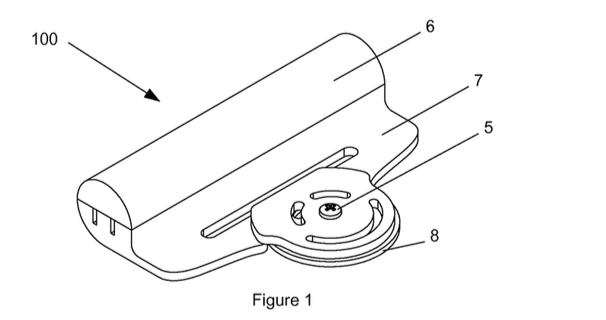Unfortunately, most examiners never experience dealing with the USPTO as an inventor. However, there is at least one former examiner who is now an inventor and representing himself pro se before the Office with respect to an invention for a Handle for Tablet Computers. If this inventor ever goes back to be an Examiner again, I suspect his experience will have an effect on how he handles cases.
The inventor, Ernesto Garcia, previously worked for more than 10 years as a USPTO examiner according to his linkedIn profile. Now, he is prosecuting at least one of his own cases, US 13/116,434. The case is very interesting for several reasons, including that the inventor has had to file multiple petitions against various Examiner actions. Further, the case is headed to appeal where Mr. Garcia recently filed an Appeal Brief.
One issue in the case is the obviousness of the claimed handle. Mr. Garcia's invention is illustrated in the Figured below where a cleaner (6a) for cleaning the tablet is positioned in the cavity in the first portion 6.
In one of the many obviousness rejections set forth by the USPTO, the examiner argues that it would be obvious to use a container in a trowel that is designed to hold toilet paper to modify another reference similar to Mr. Garcia's configuration. Mr. Garcia rightly criticizes the combination. The trowel reference (US 5,57,240) is all about enabling someone to go into nature and still have access to nicely rolled toilet paper for personal hygiene, instead of stuffing it in their pocket. The idea of adding a toilet paper holder to a reference dealing with holding a tablet is hard to justify. Mr. Garcia's invention is about holding a cleaner to clean the tablet, not the user's ... well... you know. Mr. Garcia explains this bluntly to the Examiner as follows:
You have to admit he has a point.
Another interesting issue is that the Examiner added a new 112 rejection as a Final rejection dated 7/28/2014, alleging that the term "contain" was unclear. Here, the Examiner explains that the newly amended feature to claim 1 created a problem with the already present term "contain." Mr. Garcia petitioned the rejection as improper. The Office of petitions denied his request to withdraw the finality of the rejection. While it is true that a new ground of rejection is only proper if necessitated by applicant’s amendment, here the Office confirmed that the problem was not the term "contain" by itself, but the combination with the newly added feature. Therefore, the petition was denied. The lesson here is that if there is any way for an examiner to argue that the new ground of rejection is related to an amendment, the Office of Petitions will maintain the finality of the rejection, even if the underlying rationale is somewhat dubious.
Mr. Garcia's petition issues were not over, however. In preparing the case for appeal, Mr. Garcia filed an amendment after final rewriting claims in independent form. Such an amendment must be entered, evan after a final rejection. Surprisingly, the Examiner refused entry and Mr. Garcia was forced to petition. The Office of Petitions confirmed that the amendments must be entered as they reduce issues for appeal, but imagine if Mr. Garcia was paying a representative to handle these issues. These irregularities would have cost hundreds of dollars - just to force the Examiner to do something he should have done in the first place.
Mr. Garcia has now filed his appeal brief and awaits the Examiner's Answer, or other action on the merits. I am sure he now has a better appreciation of what so many inventors face in navigating through the unforgiving waters of the USPTO.



